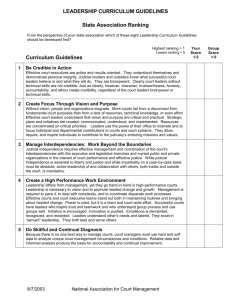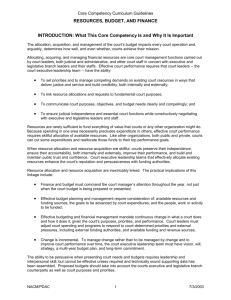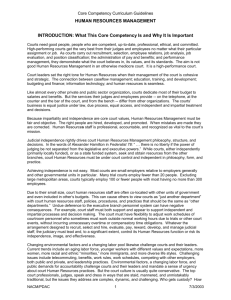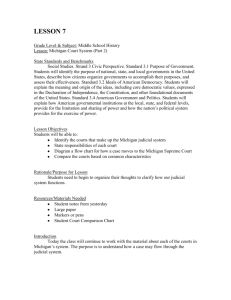Leadership - National Association for Court Management
advertisement
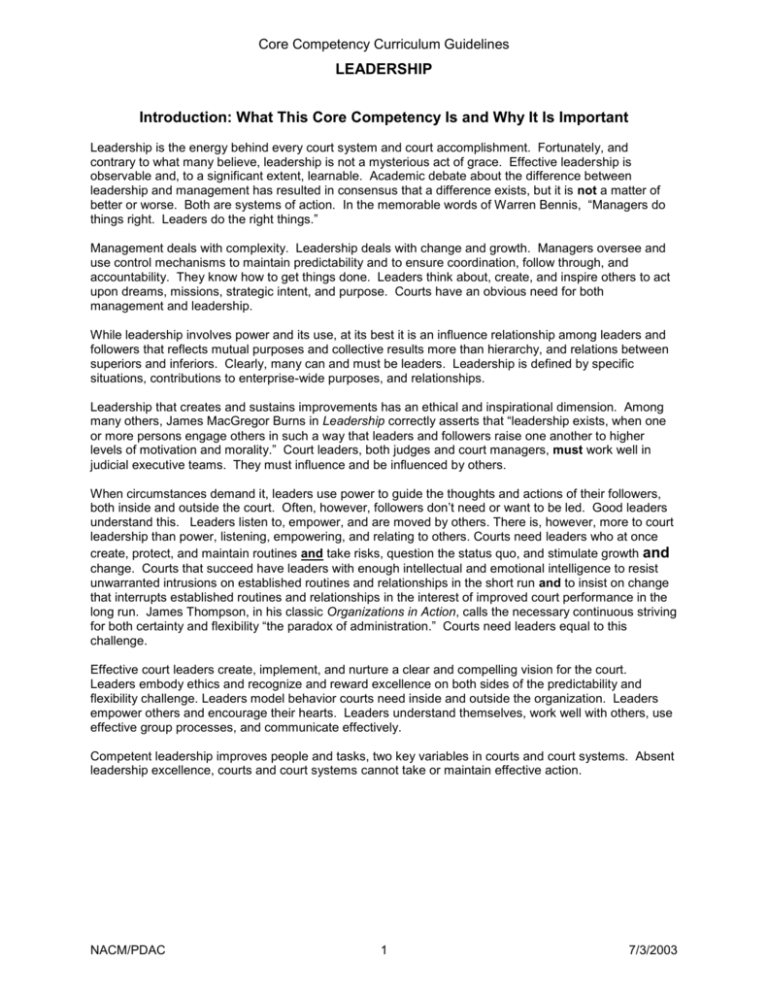
Core Competency Curriculum Guidelines LEADERSHIP Introduction: What This Core Competency Is and Why It Is Important Leadership is the energy behind every court system and court accomplishment. Fortunately, and contrary to what many believe, leadership is not a mysterious act of grace. Effective leadership is observable and, to a significant extent, learnable. Academic debate about the difference between leadership and management has resulted in consensus that a difference exists, but it is not a matter of better or worse. Both are systems of action. In the memorable words of Warren Bennis, “Managers do things right. Leaders do the right things.” Management deals with complexity. Leadership deals with change and growth. Managers oversee and use control mechanisms to maintain predictability and to ensure coordination, follow through, and accountability. They know how to get things done. Leaders think about, create, and inspire others to act upon dreams, missions, strategic intent, and purpose. Courts have an obvious need for both management and leadership. While leadership involves power and its use, at its best it is an influence relationship among leaders and followers that reflects mutual purposes and collective results more than hierarchy, and relations between superiors and inferiors. Clearly, many can and must be leaders. Leadership is defined by specific situations, contributions to enterprise-wide purposes, and relationships. Leadership that creates and sustains improvements has an ethical and inspirational dimension. Among many others, James MacGregor Burns in Leadership correctly asserts that “leadership exists, when one or more persons engage others in such a way that leaders and followers raise one another to higher levels of motivation and morality.” Court leaders, both judges and court managers, must work well in judicial executive teams. They must influence and be influenced by others. When circumstances demand it, leaders use power to guide the thoughts and actions of their followers, both inside and outside the court. Often, however, followers don’t need or want to be led. Good leaders understand this. Leaders listen to, empower, and are moved by others. There is, however, more to court leadership than power, listening, empowering, and relating to others. Courts need leaders who at once create, protect, and maintain routines and take risks, question the status quo, and stimulate growth and change. Courts that succeed have leaders with enough intellectual and emotional intelligence to resist unwarranted intrusions on established routines and relationships in the short run and to insist on change that interrupts established routines and relationships in the interest of improved court performance in the long run. James Thompson, in his classic Organizations in Action, calls the necessary continuous striving for both certainty and flexibility “the paradox of administration.” Courts need leaders equal to this challenge. Effective court leaders create, implement, and nurture a clear and compelling vision for the court. Leaders embody ethics and recognize and reward excellence on both sides of the predictability and flexibility challenge. Leaders model behavior courts need inside and outside the organization. Leaders empower others and encourage their hearts. Leaders understand themselves, work well with others, use effective group processes, and communicate effectively. Competent leadership improves people and tasks, two key variables in courts and court systems. Absent leadership excellence, courts and court systems cannot take or maintain effective action. NACM/PDAC 1 7/3/2003 Core Competency Curriculum Guidelines LEADERSHIP CURRICULUM GUIDELINES SUMMARY What Court Leaders Need to Know and Be Able to Do Leadership competency includes five areas which encompass personal characteristics and acquired knowledge, skill, and ability developed and refined through study, reflection, observation of others, practice, and, very importantly, experience. These five areas are: Be credible in action Create focus through vision Manage interdependencies and work beyond the boundaries Produce a high performance environment Do skillful and continual diagnosis All can be improved through study, reflection, observation, practice, and experience. Be Credible in Action Character matters. Likewise trustworthiness, honesty, integrity, accountability, and ethics are important. By the widest margins, in every NACM survey of experienced court managers, these attributes were found to be both essential and in great need of attention and improvement. This squares with the research of others. Knowledge of one’s limitations, personal style, values, and one’s impact on others is essential. Leaders communicate policies and procedures clearly, honestly, and consistently. Selfunderstanding and personal credibility determine whether or not peers, subordinates, and outsiders will accept one’s leadership, especially over the long term. Effective court leaders are action-oriented and transparent. They say what they mean, they do what they say, and everybody knows it. Create Focus Through Vision and Purpose Survey after survey instructs that workers often, and perhaps even usually, do not know what is expected of them. Organizational goals, objectives, and responsibilities are seldom communicated. If there is communication, it is often done poorly. Purpose is missing. Motivation flows from perceptions that court work is important and contributes to worthy court purposes. There are no insignificant court jobs. Leaders align individual performance and broad court purposes. They create vision, establish action plans that flow from that vision, and with the help of others, clearly communicate the roles of departments and individuals in attaining that vision. Power and participation are balanced. Leaders think in the long term and focus their own efforts and the efforts of others on core court purposes and the need to transition from the present to an inspired future. Manage Interdependencies: Work Beyond the Boundaries Judicial independence is an indispensable means to the ends of liberty, social order, due process, equal protection, and justice under law. But, neither theory nor practice should ever confuse judicial autonomy with judicial independence. The framers of our federal Constitution affirmed, valued, and reinforced the tension between independence and interdependency. When arguing for ratification of the Constitution in The Federalist Papers, they recognized concurrent powers and declared in Federalist 51 that “Every department should have a will of its own,” and in Federalist 78 that “…the judiciary… has neither force nor will, but merely judgment,” System interdependencies place power and resources needed by courts in the executive and legislative branches. Operating and decision-making interdependencies with other justice organizations, the private bar, insurers, and, increasingly, public and private social service providers, among others, must be managed if even simple cases are to be resolved and disposed, efficiently and fairly. Court managers must lead beyond the boundaries of the court. Effective judicial leaders and their executive teams understand constitutional separation of powers, the adversarial process, and politics. They anticipate NACM/PDAC 2 7/3/2003 Core Competency Curriculum Guidelines LEADERSHIP developments that will affect court operations and create and support coalitions to maintain routines, to produce just dispositions, and to make positive change. Create a High Performance Work Environment Change and complexity demand effective court leadership at all levels. High-performance courts recruit, select, and develop their personnel knowing that thought, decisions, and discretion are best not concentrated at the very tip of the judicial hierarchy, whether at the level of the state or its constituent trial and appellate courts. Initiative is encouraged in the understanding that courts must leverage scarce resources, both human and otherwise. Innovation is not only allowed and encouraged, it is expected. To inspire trust and teamwork, court leaders must understand group process and group facilitation methods and how, when, and where to use teams. Judges and managers, whether elected or appointed, model effective partnerships. What they do benefits and reflects the needs of others outside and inside the court and its hierarchy. They understand and practice “servant” leadership. Do Skillful and Continual Diagnosis There is no one best way to manage courts or any other organization. Cookie-cutter solutions are impractical. Effective court leaders, therefore, value and use processes and skills that measure court performance and progress toward stated goals. They want to know and continually ask and seek answers to the “How well are we doing?” question. Through use of Visioning and Strategic Planning tools and other means, effective court leaders use forecasts of future needs and conditions. They act on the needs and expectations of the public and regular court users. They analyze political conditions and anticipate developments. They seek and use hard and soft performance data. They have the ability to separate unimportant facts from important findings, trivial and self-serving observations from critical data, and insignificant readings from vital signs. NACM/PDAC 3 7/3/2003 Core Competency Curriculum Guidelines LEADERSHIP CURRICULUM GUIDELINES REQUIRED KNOWLEDGE, SKILL, AND ABILITY BE CREDIBLE IN ACTION CREATE FOCUS THROUGH VISION AND PURPOSE MANAGE INTERDEPENDENCIES: WORK BEYOND THE BOUNDARIES CREATE A HIGH PERFORMANCE ENVIRONMENT DO SKILLFUL AND CONTINUAL DIAGNOSIS NACM/PDAC 4 7/3/2003 Core Competency Curriculum Guidelines LEADERSHIP BE CREDIBLE IN ACTION Effective court executives are action and results oriented. They understand themselves and demonstrate personal integrity. Judicial insiders and outsiders know what successful court leaders believe in and what they will do. They are transparent. Clearly court leaders without technical skills are not credible. Just as clearly, however, character, trustworthiness, honesty, accountability, and ethics create credibility, regardless of the court leaders brainpower or technical skills. Ability to demonstrate integrity, trustworthiness, honesty, accountability, ethics, and integrity in one’s actions; Knowledge of one’s strengths and limitations; Knowledge of codes of conduct including judicial and court manager codes in relevant federal, state, and local jurisdictions; the National Association for Court Management Model Code of Conduct; the model code for court managers developed by the American Judicature Society; the ABA Canons of Judicial Ethics for judges; and the ABA Code of Professional Conduct for lawyers; Knowledge of ethical issues and legal regulations when dealing with legal, personnel, and human resource issues, contracting, purchasing, and the management of court funds; Skill in projecting competence and professionalism; Ability to maintain objectivity, neutrality, and freedom from bias of any type toward any group or individual; Skill in clear, direct, and consistent communication; Ability to model desired behaviors; and Knowledge of personal values, how these values and personal style impact others who work in and around the courts, and how values and style set the culture and tone of the court. NACM/PDAC 5 7/3/2003 Core Competency Curriculum Guidelines LEADERSHIP CREATE FOCUS THROUGH VISION AND PURPOSE Without vision, people and organizations stagnate. More courts fail from a disconnect from fundamental court purposes than from a lack of resources, technical knowledge, or even effort. Effective court leaders understand that vision and purpose are critical and practical. Strategic plans and initiatives are created, communicated, understood, and implemented. Resources are concentrated on critical priorities. Leaders use the power of their office to motivate and to focus individual and departmental contributions to courts and court systems. They allow, require, and inspire individuals to contribute to the judiciary’s enduring missions and values. Knowledge of the Purposes and Responsibilities of Courts; Ability to work with others to create a clear vision and sense of purpose for the court, its departments, and employees; Ability to communicate strategic intent, vision, and sense of purpose for the court and establish and execute action plans that reflect that vision; Ability to forecast future needs and conditions of the court and to think in the long term; Ability to analyze political and social trends and to anticipate their impact on court resource needs and operations; Knowledge of how to integrate short-term objectives into longer-term strategic plans; Ability to prioritize and to focus and concentrate individuals and resources on the most critical court needs; Skill in recognizing, communicating with, and motivating judges, administrative staff, attorneys, and others on whom the court depends to achieve its objectives; and Ability to communicate court mission, goals, and vision and to build deserved public trust and confidence in the judiciary. NACM/PDAC 6 7/3/2003 Core Competency Curriculum Guidelines LEADERSHIP MANAGE INTERDEPENDENCIES: WORK BEYOND THE BOUNDARIES Judicial independence requires effective management and coordination of the court’s interdependencies with the executive and legislative branches and myriad public and private organizations in the interest of court performance and effective justice. While judicial independence is essential to liberty and justice and while impartiality on a case-by-case basis must be absolute, active leadership of and collaboration with others, both inside and outside the court, is mandatory. Knowledge of the basis for the judiciary’s assertions of judicial independence and inherent powers and their relationship to the ends of liberty, social order, due process, equal protection, and justice under law; Ability to create coalitions for effective routines and needed change; Ability to develop and foster system-wide cooperation including strong affirmative relationships between elected and appointed court leaders, the public and private bar, law enforcement agencies, and other private, local, and state based social service and justice providers; Knowledge of the roles and resulting motives of actors in various subsystems inside and outside the court; Skill in effective communication of court requirements and accomplishments to external authorities; Skill and political awareness when working with executive and legislative funding authorities; Ability to minimize turf battles without losing turf; Knowledge of political and interpersonal skills relevant to the court’s negotiations and lobbying; Ability to marshal resources and to establish collaborative programs and partnerships, both public and private; and Skill in leading, surviving, and thriving in the face of conflicting mandates, ambiguous jurisdiction, and overlapping responsibilities. NACM/PDAC 7 7/3/2003 Core Competency Curriculum Guidelines LEADERSHIP CREATE A HIGH PERFORMANCE WORK ENVIRONMENT Leadership differs from management, yet they go hand-in-hand in high-performance courts. Leadership is necessary to vision and to promote needed change and growth. Management is required to pace it, to deal with complexity, and to coordinate disparate work processes. Effective courts and court executive teams stand out both in maintaining routines and bringing about needed change. Power is used, but it is a team and court-wide effort. Successful courts have leaders who inspire trust and teamwork and who understand group process and use groups well. Initiative is encouraged. Innovation is pushed. Excellence is demanded, recognized, and rewarded. Leaders understand other’s needs and talents. They excel in “servant” leadership. They both lead and serve others. Knowledge of the judicial executive team concept and its practical importance for acceptable court performance; Ability to forge an effective court executive team and to model effective judge and court manager partnerships; Ability to work effectively with management and technical staff and teams to develop effective caseflow and other work processes; Knowledge of the classic and current management and leadership literature; Ability to inspire trust, teamwork, and high court performance; Ability to use power, to make decisions, and to act decisively; Knowledge of motivational principles and methods and how to provide timely and constructive feedback; Ability to motivate justice partners and staff contributions to the court’s mission; Ability to delegate and to avoid getting bogged down in details and micro management; Ability to lead and to manage change; Skill in listening, coaching, and mentoring, and developing effective court teams; Skill in balancing professional, family, and personal needs and in helping others see the value in achieving balance between their work and personal lives; and Ability to support and to advance innovation and improved court performance. NACM/PDAC 8 7/3/2003 Core Competency Curriculum Guidelines LEADERSHIP DO SKILLFUL AND CONTINUAL DIAGNOSIS Because there is no one best way to manage courts, court managers must use hard and soft data to analyze unique court management circumstances and conditions. Reliable data and informed analysis produce the basis for accountability and continual improvement. Knowledge of information and data needs; national, state, and local databases; how to acquire needed information; how to analyze necessary data; and how to use statistics, analytic staff, and reports; Ability to be inquisitive about and to scrutinize court performance openly, honestly, and continually; Skill in problem recognition and definition, diagnosis, analysis, and in finding alternative solutions; Ability to use objective data and anecdotal information when considering or conducting performance assessments; Skill in thinking logically and outside the box; Knowledge of the Trial Court Performance Standards and the accompanying assessment and measurement system; Skill in using performance measurement, resource allocation tools, and benchmarking to measure program costs, court performance, and outcomes; Knowledge of strategies, techniques, and skills such as total quality management and current management tools; and Skill in making adjustments based on assessments of how well the court is doing. NACM/PDAC 9 7/3/2003



